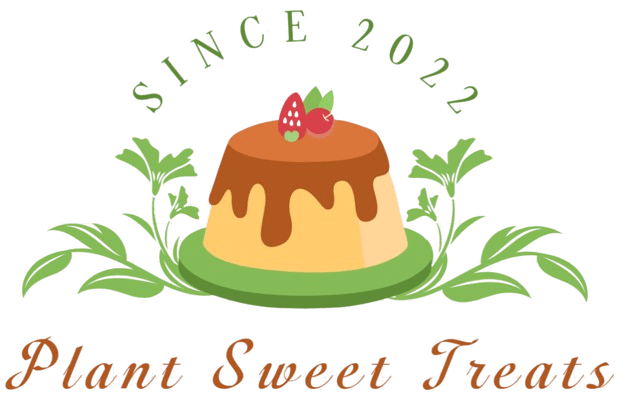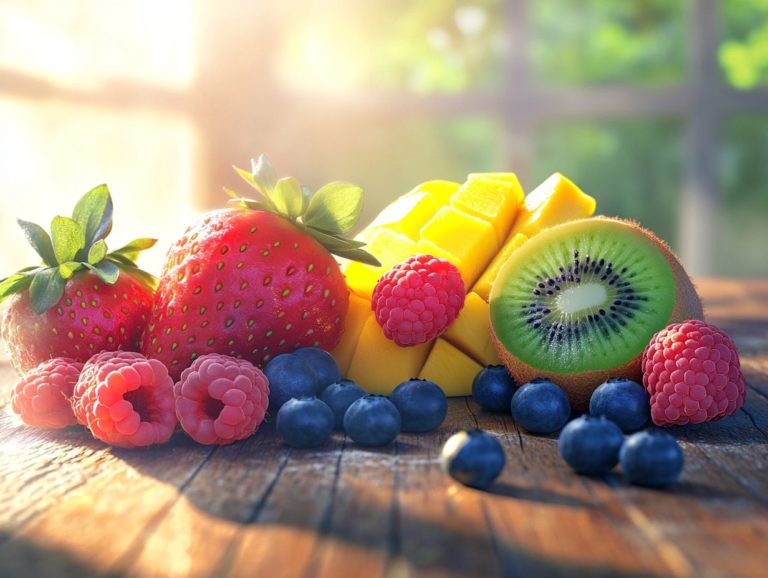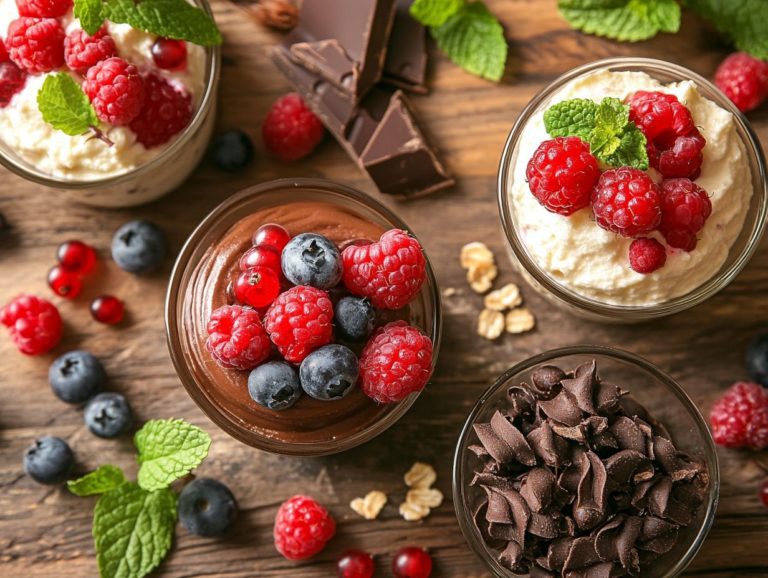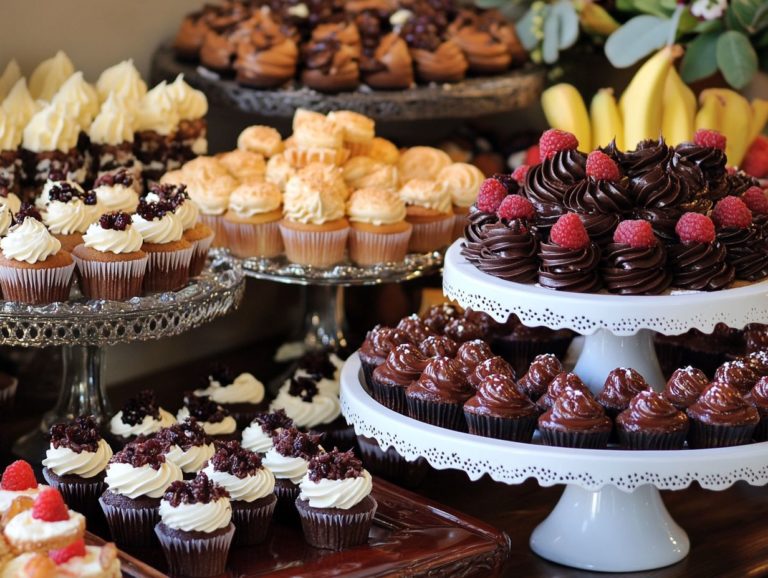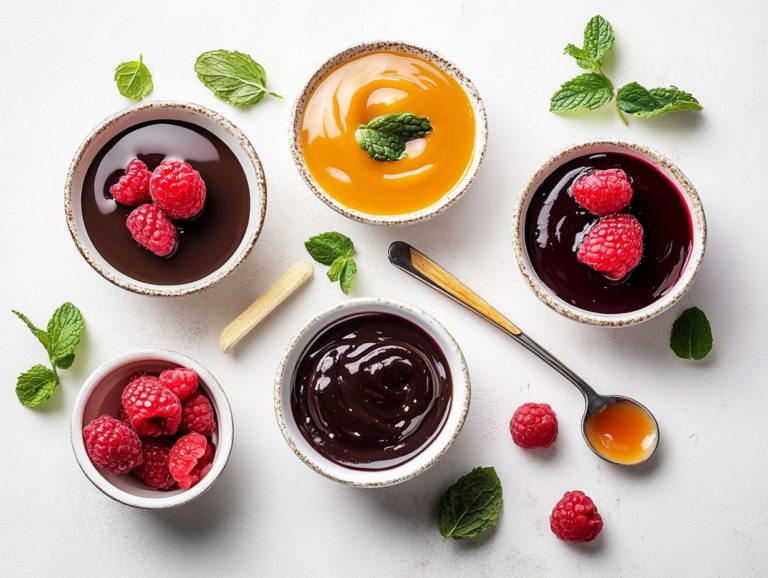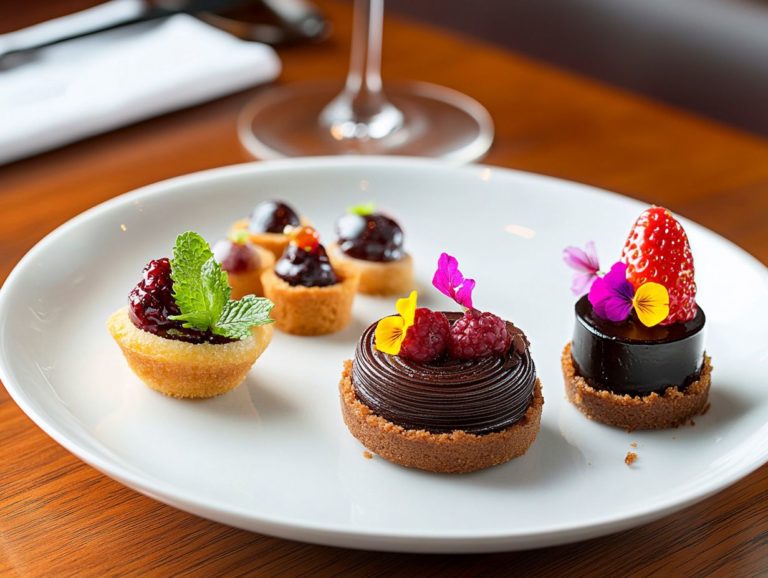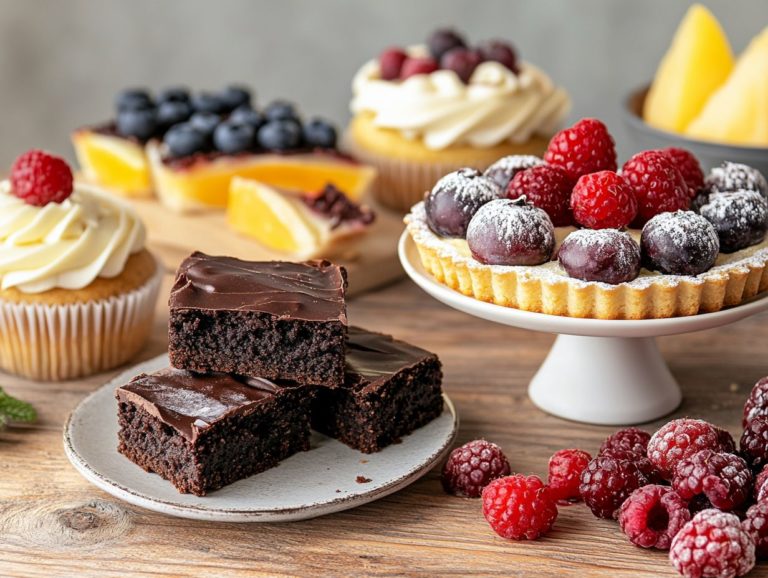How to Use Edible Flowers in Dessert Decoration?
Get ready to wow your guests with stunning, flower-topped desserts! Edible flowers offer a vibrant and delightful way to elevate your dishes, infusing them with color, unique flower flavors, and a touch of elegance. Whether you’re inspired by floral arrangements or botanical baking, edible flower recipes can transform any creation.
In this article, you ll discover what edible flowers are, how to select the perfect ones for your dishes, and the safest varieties to consider. You ll explore their health benefits, preparation methods, and the most creative ways to incorporate them into baking and beverages. We will also delve into the realm of flower safety, avoiding poisonous flowers while emphasizing the importance of flower preparation.
You ll find essential tips on cleanliness, storage, and precautions that will ensure your culinary adventures are not only beautiful but also safe.
With baking tips from experts like Bronwen Wyatt and Pamela Thibodeaux, your creations will surely impress.
Contents
- Key Takeaways:
- What Are Edible Flowers?
- Choosing Edible Flowers for Dessert Decoration
- Which Types of Edible Flowers Are Safe to Eat?
- How to Prepare Edible Flowers for Dessert Decoration?
- How to Store Edible Flowers for Later Use?
- What Are Some Creative Ways to Use Edible Flowers in Dessert Decoration?
- Are There Any Precautions to Take When Using Edible Flowers in Dessert Decoration?
- Where Can You Find Edible Flowers for Dessert Decoration?
- Frequently Asked Questions
- What are some tips for using edible flowers in dessert decoration?
- What types of edible flowers are best for dessert decoration?
- How should I prepare edible flowers for dessert decoration?
- What are some dessert ideas for using edible flowers in decoration?
- Can I eat the edible flowers used in decoration?
- Are there any precautions I should take when using edible flowers in dessert decoration?
Key Takeaways:
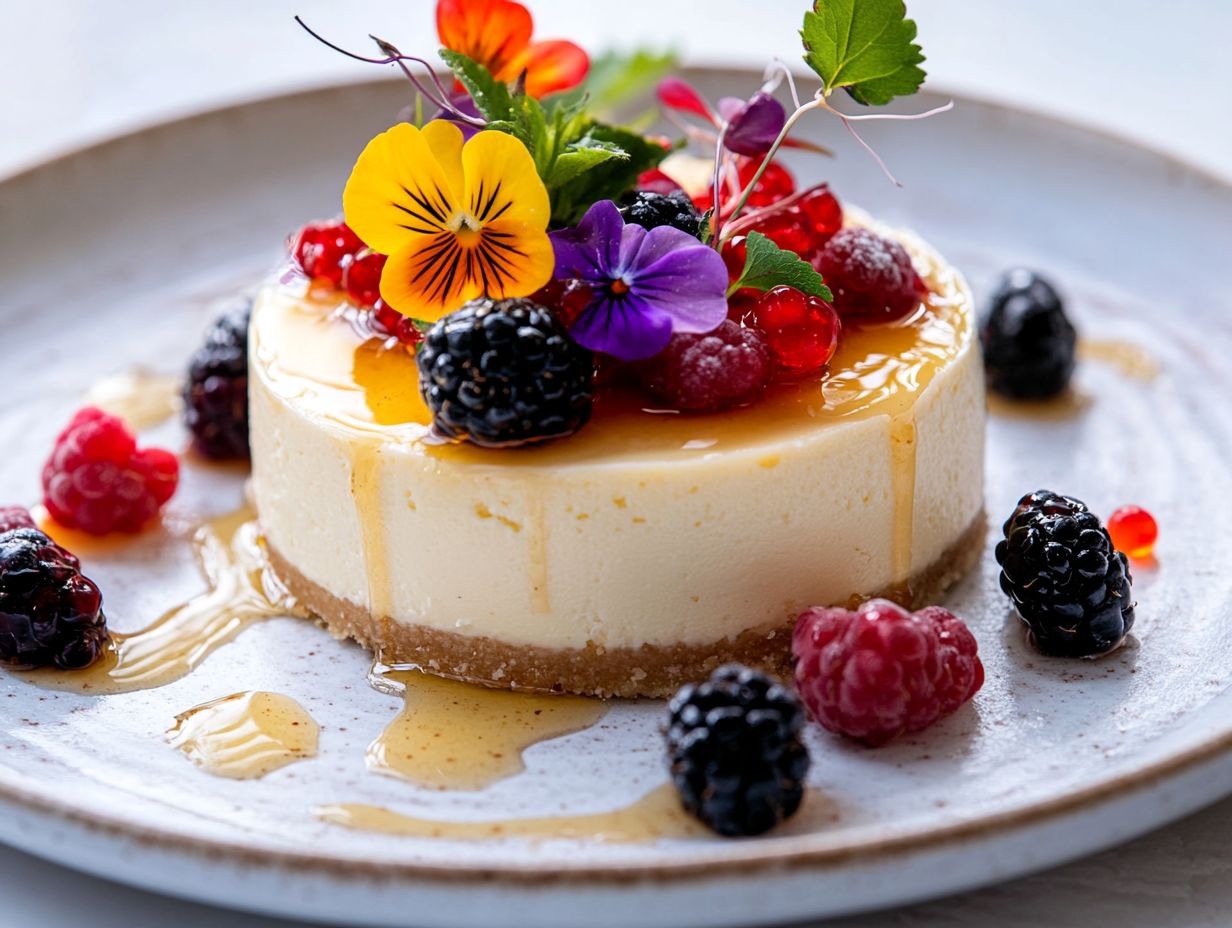
- Choose edible flowers carefully. Ensure they are safe to eat and free from pesticides.
- Use edible flowers creatively to add beauty and flavor.
- Be cautious of allergies and always clean and store flowers properly.
What Are Edible Flowers?
Edible flowers are not just vibrant and visually captivating; they are also flavorful blooms that elevate the taste of your dishes. Their growing popularity in cake decorating and gourmet baking speaks to their versatility.
With an array of non-toxic species at your disposal, these flowers add a unique flair to everything from decadent desserts to savory dishes. Whether you re a professional chef or a passionate home baker, incorporating floral design into your presentations allows you to craft stunning and delicious dishes that celebrate the beauty of seasonal blooms while supporting local farmers chemical-free flowers.
Choosing Edible Flowers for Dessert Decoration
Choosing the right edible flowers for your dessert decoration is crucial in enhancing both the aesthetic appeal and the flavor profile of your dishes. When selecting these floral garnishes, consider important factors like the season, freshness, and sourcing from trusted local farmers or floral suppliers who provide chemical-free options.
Florist tips often recommend checking flower markets or specialized suppliers like Cloverhill Flowers, Gourmet Sweet Botanicals, and Fresh Origins for quality blooms. To achieve a harmonious blend, think about the flavors that will beautifully complement your dessert perhaps delicate lavender for cakes or vibrant chamomile for tarts.
Using tips from florists and floral cake decorators can elevate your floral design to new heights, making your desserts not just tasty, but visually stunning as well.
Which Types of Edible Flowers Are Safe to Eat?
Understanding which edible flowers are safe to consume is essential for anyone looking to explore the art of baking using flowers or cake decorating. While many flowers are undeniably beautiful and enticing, it’s vital to differentiate between those that are safe to eat and those that are toxic and could lead to adverse reactions.
A well-curated edible flower guide can offer you valuable insights into specific varieties like nasturtiums, violets, and pansies, all celebrated for their delightful flavors and safety. This knowledge gives you the power to make informed choices as you embark on your floral culinary endeavors.
What Are the Most Commonly Used Edible Flowers?
Some of the most delightful edible flowers you can incorporate into your culinary creations include chamomile, which boasts a sweet, apple-like flavor, and lavender, known for its fragrant allure that enhances desserts beautifully. Alongside other charming varieties like nasturtiums and pansies, these flowers have seamlessly integrated into recipes for cakes, infusions, and even salads, thanks to their captivating colors and distinctive taste profiles.
Experts like Loria Stern, who founded Eat Your Flowers, often recommend these blooms for their unique flavors and visual appeal.
By introducing these edible blooms into your dishes, you elevate their visual appeal. They also infuse unique flavors that transform your baking and dessert endeavors.
Consider nasturtiums; their peppery kick adds a delightful contrast to savory dishes. Pansies lend a gentle sweetness, making them an ideal complement to light salads. Hibiscus flowers, with their tart profile, are perfect for cocktails and jams, infusing vibrant hues into them.
Each of these edible blossoms brings its unique flavor to your cooking. They also serve as stunning visual elements that turn an ordinary plate into beautiful dishes. From Texas to Ontario, chefs and home bakers alike are embracing these flowers to enhance their dishes.
Whether you re garnishing a gourmet dish or enriching a simple dessert, these flowers invite you to embrace a delightful and adventurous approach to cooking!
What Are the Health Benefits of Eating Edible Flowers?
Eating edible flowers can offer an array of health benefits, making them a delightful addition to your diet. Many edible varieties, such as hibiscus and dandelion, are bursting with antioxidants, vitamins, and minerals that contribute to your overall well-being. By incorporating these flowers into your meals, you not only elevate the visual appeal of your dishes but also introduce unique floral flavors that can enhance your culinary experience while promoting a healthy lifestyle through botanical baking.
Take hibiscus, for example; it’s well-known for its potential to support heart health by lowering blood pressure and cholesterol levels. Dandelions are celebrated for their diuretic properties (which can help promote kidney function). Nasturtiums bring a delightful peppery kick and are rich in vitamin C, giving your immune system a boost. And let s not forget about lavender this lovely flower is perfect for crafting calming herbal teas that aid in relaxation. Cloverhill Flowers and Framed Florals are great sources for these beneficial blooms.
By embracing these vibrant botanicals, you can transform simple meals into wellness-boosting delights, all while elevating both your palate and your health.
How to Prepare Edible Flowers for Dessert Decoration?
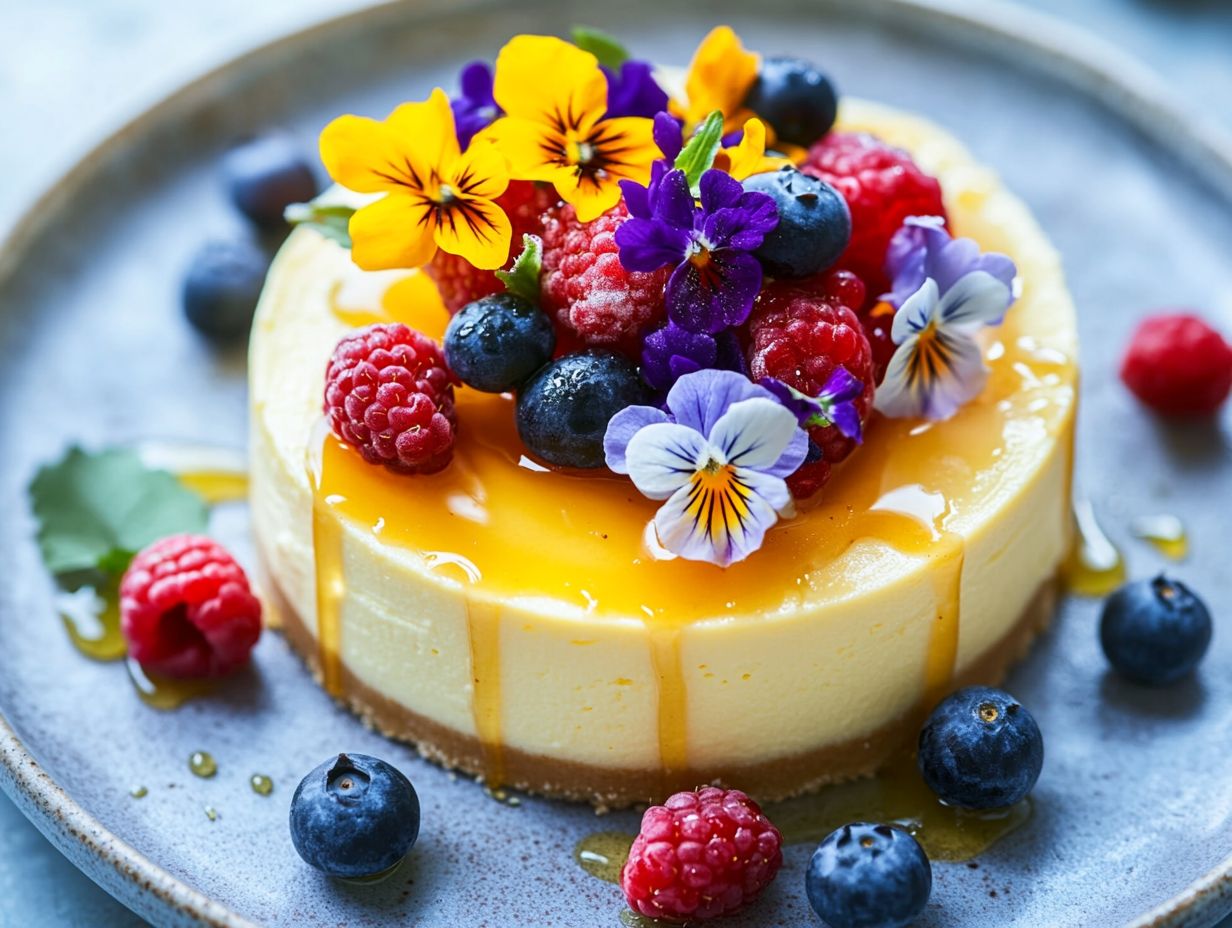
Proper preparation of edible flowers is crucial to ensure both their safety and flavor when you use them to adorn your desserts. Start by choosing fresh, pesticide-free flowers from trusted sources like local farmers who specialize in chemical-free options.
Once you’ve procured your flowers, it s essential to clean and prep them correctly remove any non-edible parts, rinse them gently, and dry them with care. By following these refined tips, you can seamlessly integrate these vibrant blooms into your designs without sacrificing taste or safety.
What Are the Proper Cleaning Methods for Edible Flowers?
The proper cleaning methods for edible flowers are essential to ensure they are safe for consumption. Start by gently rinsing the flowers under cool running water to wash away any dirt or insects. Skip the harsh chemicals or soaps; those can be harmful. Instead, if needed, use a soft brush.
After rinsing, pat the flowers dry with a clean paper towel to preserve their delicate structure. This will make them perfect for your cake decorating or cooking uses.
If you specialize in gourmet dishes, it’s wise to inspect each bloom carefully for any bruising or discoloration that might hint at spoilage. For flowers like violets and pansies, separate the petals gently and rinse them individually to ensure a thorough cleanse.
When dealing with larger flowers, such as hibiscus or nasturtiums, consider trimming the stems to avoid any lingering dirt hiding at the base.
Before using the cleaned flowers, allow them to rest on a layer of paper towels to absorb excess moisture. This will help preserve their crisp texture. Mastering these techniques will elevate your dishes to new heights! Remember, flower garnishes can turn simple cakes or desserts into elegant masterpieces.
How to Store Edible Flowers for Later Use?
Properly storing edible flowers is crucial for maintaining their freshness and flavor. Aim to keep them in a cool, dry place or, even better, in the refrigerator wrapped in a damp paper towel to prevent wilting. Use them quickly for the best flavor, especially for seasonal blooms like lavender or chamomile. This ensures optimal flavor and appearance in your floral designs.
It’s also important to keep these delicate flowers away from strong odors; they have a knack for absorbing unwanted scents, which can alter their taste. If you’re looking to store them for a longer period, consider freezing them in ice cubes or blending them into a smooth mixture for use in sauces and dressings. This way, you can preserve their vibrant colors and subtle flavors for your future culinary masterpieces.
Remember, each variety may have its own unique storage needs. For instance, soft-petaled flowers like violets usually have a shorter shelf life than sturdier blooms like nasturtiums. By planning to use flowers seasonally, you’ll enhance their flavors and ensure they harmonize beautifully with other fresh ingredients in your dishes. This method of flower sourcing is especially beneficial for those who enjoy gourmet baking and want to maintain peak freshness and flavor.
What Are Some Creative Ways to Use Edible Flowers in Dessert Decoration?
Edible flowers present an exquisite opportunity to elevate your dessert decoration. They transform everyday cakes and pastries into remarkable culinary masterpieces. As a floral cake decorator, you can integrate these blooms not only for their aesthetic appeal but also for their distinctive flavors. This brings a lively essence to treats ranging from cupcakes to tarts. Notable decorators like Bronwen Wyatt and Pamela Thibodeaux have popularized the use of these flowers in their creations.
Whether you choose to use them as elegant garnishes, infuse them into syrups, or crystallize them for a sweet touch, edible flowers can significantly enhance your baking experience. This enables you to express your creativity while leaving a lasting impression on your guests.
What Are Some Popular Desserts That Use Edible Flowers?
Popular desserts featuring edible flowers include lavender-infused cakes, strawberry tarts adorned with pansies, and chamomile-flavored ganache. Other popular options include strawberries paired with chamomile for a delightful twist. Each dessert offers a fusion of flavors and aesthetics that elevate your baking game. These floral elements enhance the visual appeal and contribute unique taste profiles that make each dessert truly stand out.
By incorporating edible flowers into your creations, you unlock endless possibilities for creativity, whether you’re designing elegant wedding cakes or refreshing summer treats. The trend of using edible flowers in desserts has gained popularity through platforms like Eat Your Flowers.
Imagine a rosewater panna cotta topped with delicate rose petals. This dish brings a hint of floral sweetness that beautifully balances its creamy texture. Similarly, a drizzle of hibiscus syrup over chocolate mousse enhances the flavor with a tart contrast while adding a vibrant splash of color.
Desserts adorned with striking nasturtiums introduce a peppery zest, transforming them from indulgences into captivating cooking experiences.
This integration of edible flowers invites you to explore new dimensions of taste and presentation, revamping traditional confections into memorable works of culinary art.
How to Use Edible Flowers in Baking?
Incorporating edible flowers into your baking can elevate your creations with a touch of elegance and introduce unique flavors that enhance both the visual and sensory experience of your desserts. Consider adding flowers like violets or nasturtiums directly into your batters, or use them as stunning garnishes on cakes and pastries.
When working with edible flowers, ensure they are fresh and free of chemicals. Don t hesitate to experiment with flavors to achieve a harmonious balance in your recipes.
To further enhance the aesthetic and taste of your baked goods, think about infusing flower petals into syrups or creams. For example, using chamomile can add a soothing aroma and flavor to your desserts, reminiscent of techniques used during World War Two for making the most out of limited ingredients.
Crafting a lavender syrup can impart a soothing aroma and flavor that s perfect for drizzling over cakes or pancakes.
Blending dried edible flowers into your flour can also create a subtle hue and flavor enhancement, making it ideal for cookies or bread. Keep in mind the seasonality of these flowers; using in-season blooms guarantees optimal freshness and flavor.
With thoughtful selection and creative application, you can transform your baking into an artful experience that delights both the eye and the palate.
How to Use Edible Flowers in Drinks and Cocktails?
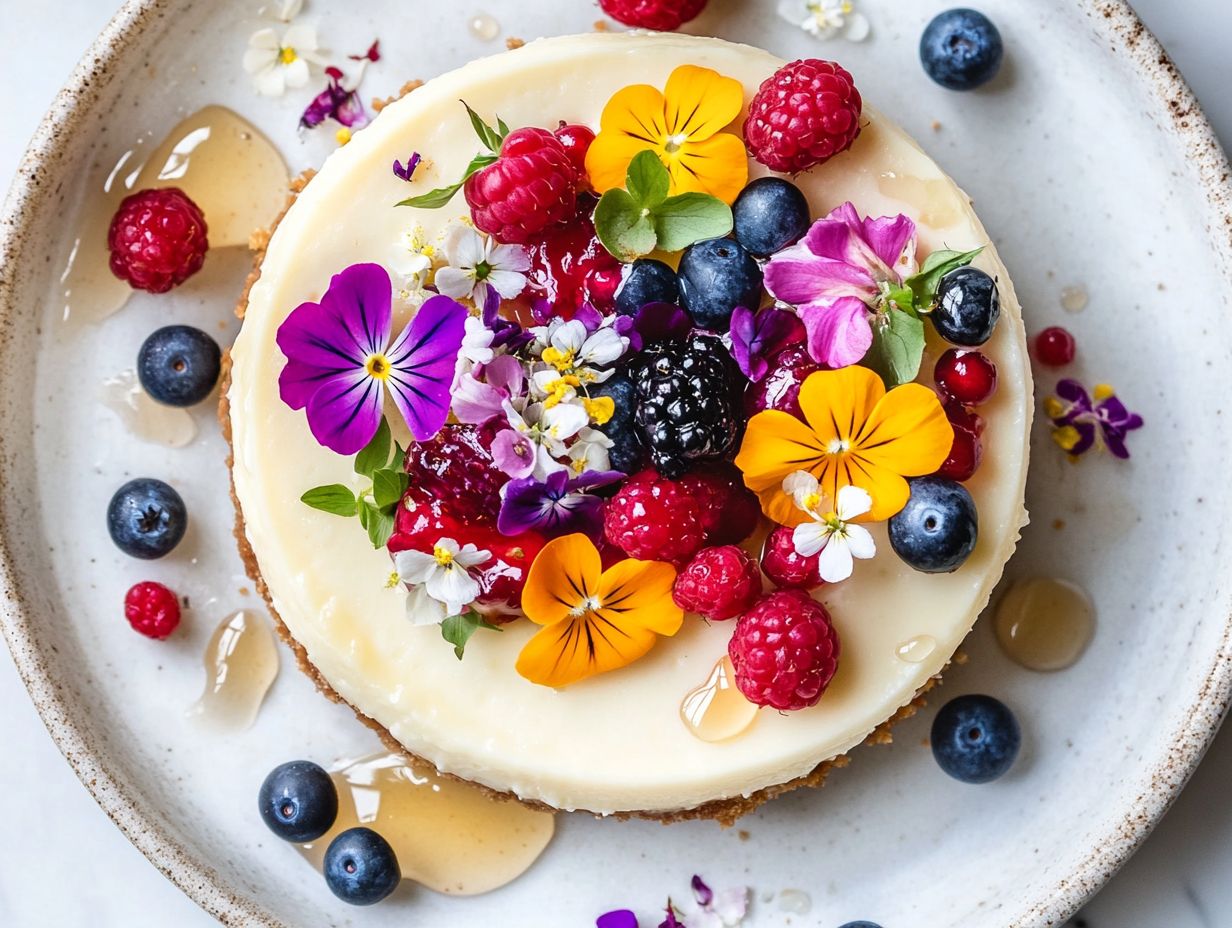
Edible flowers can transform your drinks and cocktails into visually stunning and flavorful masterpieces, infusing a touch of sophistication into every sip. Imagine incorporating flowers like lavender, hibiscus, or delicate rose petals into your creations. These floral delights can be infused into syrups or used as eye-catching garnishes, enhancing both the aroma and presentation of your beverages.
By embracing these floral elements, you elevate not just the aesthetic appeal but also introduce delightful flavor notes that beautifully complement a variety of spirits and mixers.
Consider the vibrant hibiscus-infused margarita; it offers a tangy twist on a classic that is sure to impress. Imagine how lavender syrup can elevate your gin and tonic into something extraordinary, creating a harmonious blend of floral and herbal tones that dances on the palate. The use of rose water in cocktails adds a delicate sweetness that works wonders in refreshing summer spritzers.
Whether you opt for simple infusion techniques or meticulously curated garnishes, introducing edible flowers infuses creativity and whimsy into your beverage crafting. They entice your guests with their beauty and unique taste profiles, making each drink an experience to remember.
Try incorporating edible flowers into your next culinary experiment and discover the delightful flavors and presentations they can bring to your creations!
Are There Any Precautions to Take When Using Edible Flowers in Dessert Decoration?
When you decide to use edible flowers for decorating desserts, it s crucial to take specific precautions to ensure both safety and enjoyment. Chemically treated flowers can pose health risks, so always opt for chemical-free flowers.
Not every flower is safe for consumption; some can be toxic or trigger allergic reactions. Therefore, verifying the safety of each flower before incorporating it into your culinary creations is essential.
Moreover, sourcing your flowers from reputable suppliers who offer chemical-free options will further safeguard against potential health risks, elevating your baking experience to new heights.
What Are the Potential Allergic Reactions to Edible Flowers?
Potential allergic reactions to edible flowers can vary significantly from one person to another, so it s crucial for you to approach their consumption with a degree of caution. You may encounter common symptoms such as skin rashes, digestive issues, or even respiratory discomfort if you re sensitive to certain flower varieties.
Understanding which flowers might trigger these reactions is essential for you, especially if you’re eager to incorporate them into your diet. This knowledge ensures a safe and enjoyable experience when using flowers in your baking or as decorative elements in desserts.
Several common allergens include nasturtiums, violets, and chrysanthemums, as these are known to provoke more pronounced reactions in those with sensitivities. Because of this, it s wise for you to conduct a patch test before diving into full consumption.
When you introduce these stunning additions to your dishes, starting with small quantities is a prudent approach. You can look for inspiration from floral artists like Loria Stern or Framed Florals to understand the best practices.
Consulting with a healthcare professional about allergies before adding new edible flowers to your meals can offer peace of mind and help you identify any potential triggers.
Being well-informed allows you to delight in the culinary possibilities that edible flowers present, enhancing both the flavor and visual appeal of your dishes.
Can Edible Flowers Be Harmful If Not Used Properly?
Edible flowers can pose significant risks if not handled with care, as some varieties may be toxic or lead to adverse health effects when ingested. It s essential for you to distinguish between safe and poisonous flowers, as consuming the latter could result in serious health complications.
Responsible sourcing and thorough research into the types of flowers you choose for culinary use are paramount in avoiding any pitfalls associated with their consumption. By understanding flower safety, you can ensure a delightful experience in your baking and dessert decoration.
If you re looking to elevate your dishes with these vibrant ingredients, keep in mind that not all blooms are created equal. Some can harbor harmful compounds that might lead to gastrointestinal distress, allergic reactions, or even more severe consequences. This underscores the need for you to verify the origin and treatment of edible flowers, steering clear of those sourced from public areas or unknown suppliers, where pesticides and pollutants may introduce additional hazards.
By following recommended guidelines and seeking out reputable suppliers, you can savor the beauty and flavor of these botanical delights while prioritizing safety in your kitchen. You can find these flowers in regions like Texas and Ontario, known for their rich variety of chemical-free flowers.
Where Can You Find Edible Flowers for Dessert Decoration?
Discovering edible flowers for your dessert decoration can be an exhilarating and rewarding journey. These delightful blooms are easily accessible from a range of sources, including local farmers, specialty grocers, and vibrant flower markets. Renowned suppliers like Cloverhill Flowers, Gourmet Sweet Botanicals, and Fresh Origins are great places to find high-quality options.
By sourcing your flowers from trusted suppliers, you ensure that you’re selecting high-quality, chemical-free options that are safe for consumption. Furthermore, a visit to farmers’ markets allows you the unique opportunity to engage directly with growers, who can share valuable insights into the best seasonal varieties and provide guidance on how to use them effectively in your culinary creations.
Frequently Asked Questions
What are some tips for using edible flowers in dessert decoration?
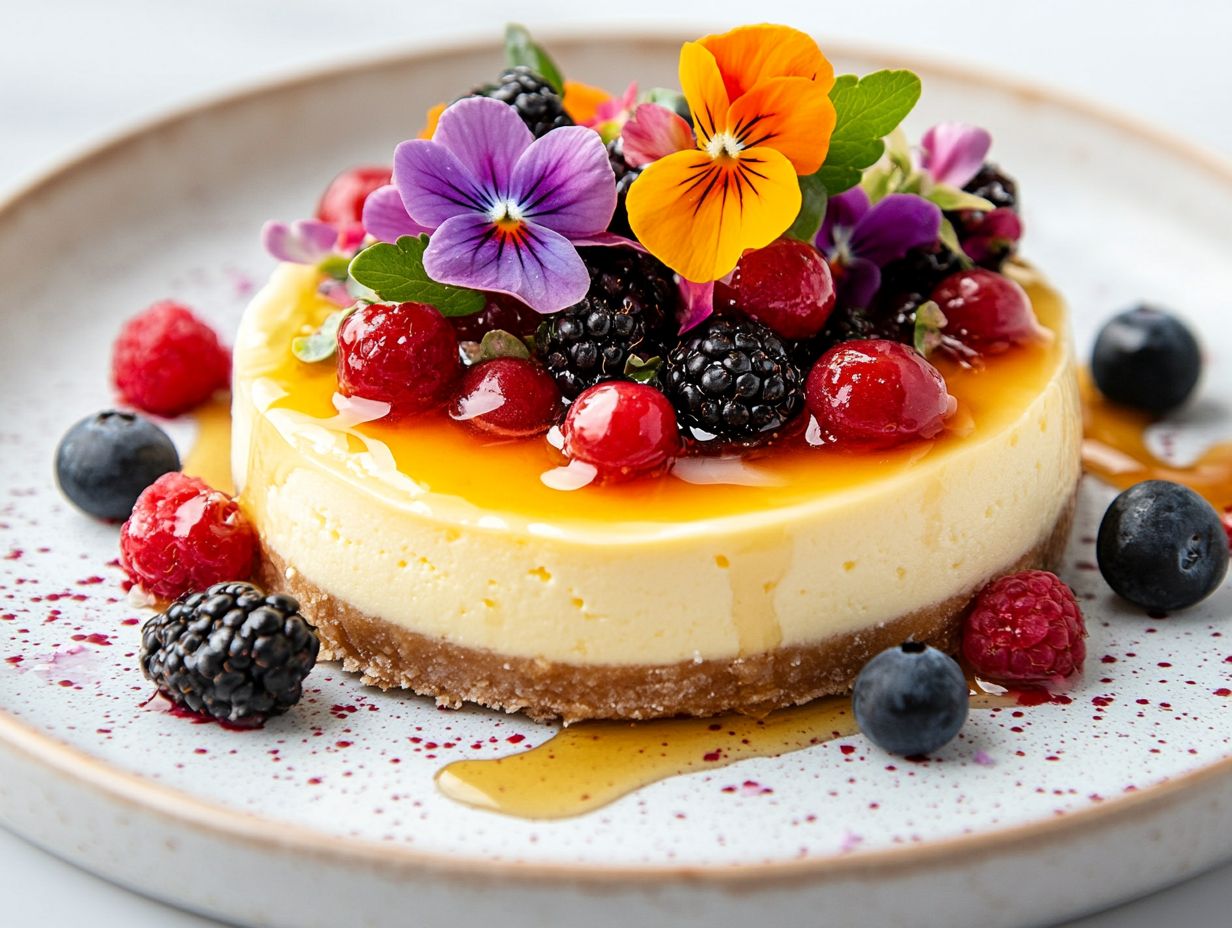
First, make sure the flowers you are using are edible and have not been treated with any chemicals. Consider the flavor and scent of the flowers when pairing them with desserts. Thoroughly wash and dry the flowers before using them in decoration.
What types of edible flowers are best for dessert decoration?
Popular edible flowers for desserts include:
- Roses
- Lavender
- Violets
- Pansies
These flowers have delicate flavors that perfectly complement sweet treats.
How should I prepare edible flowers for dessert decoration?
Wash and dry the flowers thoroughly. Remove stems, leaves, and pistils from larger flowers for a cleaner decoration.
What are some dessert ideas for using edible flowers in decoration?
Transform your desserts into stunning works of art with edible flowers! Use them to decorate cakes, cupcakes, tarts, and even ice cream. You can also add flavor to syrups, creams, and jellies for a floral twist on traditional desserts. Notable chefs like Loria Stern and Bronwen Wyatt use flowers from Cloverhill Flowers in Texas or Fresh Origins in their creations.
Can I eat the edible flowers used in decoration?
Yes, as long as they are edible and have been properly washed and prepared. However, some people may have allergies to certain types of flowers. Always check for allergies before serving desserts with flowers. Chamomile and other flowers from Gourmet Sweet Botanicals are popular choices.
Are there any precautions I should take when using edible flowers in dessert decoration?
Avoid using flowers from florists or garden centers, as these may have been treated with pesticides. Only use flowers that are labeled as edible. If unsure, it’s best to err on the side of caution and refrain from using them in decoration. For trusted sources, consider suppliers like Framed Florals in Ontario and Eat Your Flowers by Pamela Thibodeaux.
